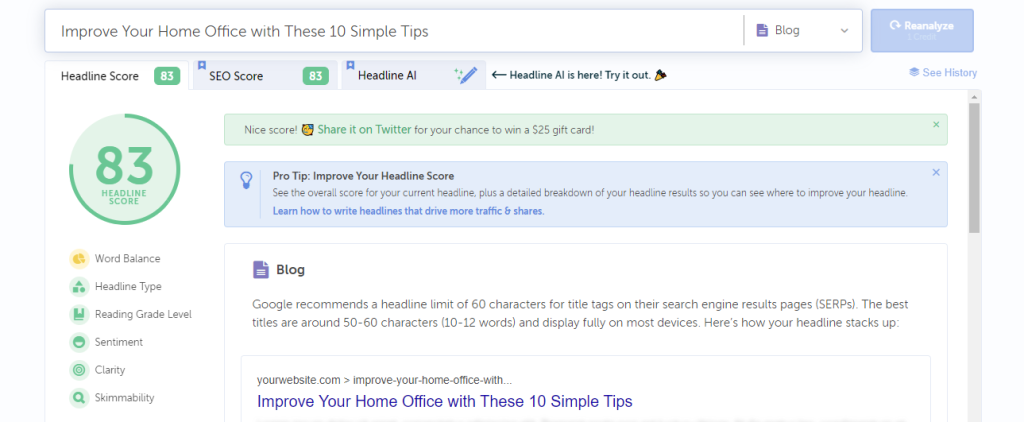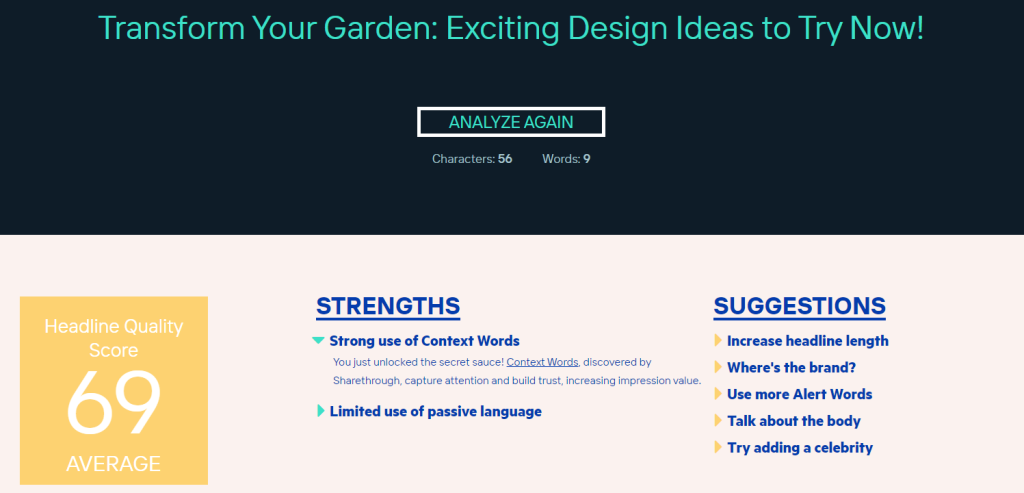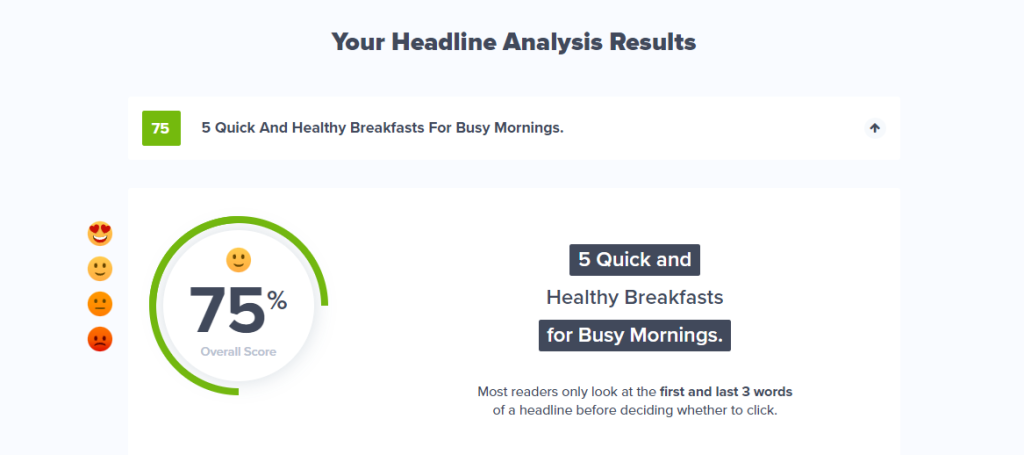More than being a title, your headline serves as an invitation to your readers. But with the abundance of content online, the ability to write catchy titles is a necessity to thrive.
Let’s have some numbers to back this up. On average, only 20% of those who read your headline will proceed with the entire article. In short, mediocre headlines lose 80% of your potential traffic.
Marketers would always say that content is king. And the first part of that content is your headline. With that, it’s safe to say that headlines can make or break your entire piece.
So as a writer, don’t just write good headlines. Make great ones that your readers will find irresistible to learn more. To help you with that, here are 16 of the best tips that you can use to write catchy titles.
Tips for Creating Great Titles and Headlines
1. Be Descriptive But Keep It Simple
You want your headline to be vivid and descriptive, to draw readers in. But it’s important to keep it straightforward. This ensures your message is clear and easily understood.
A descriptive headline gives a sneak peek into your content. It sets the scene for your readers.
For instance, instead of “Good Breakfast Ideas,” a more descriptive headline would be “5 Quick and Healthy Breakfasts for Busy Mornings.” This tells the reader exactly what to expect and is more engaging.
However, simplicity is crucial. You don’t want to overwhelm your readers with too many words or complex ideas in a headline. The trick is to convey your message in the simplest terms possible.
For example, “Efficient Strategies for Time Management at Work” can be simplified to “5 Simple Time-Saving Tips for Your Workday.” It’s direct and easy to grasp.
2. Do Keyword Research
Keyword research is a powerful tool in headline creation. It involves identifying popular terms and phrases that people frequently search for online.
First, know what your readers like and what they search for. Then, you can use tools like SEMRush to search for potential keywords for these topics.
Let’s say you’re writing about digital marketing. Possible keywords for it can be “SEO strategies” or “tips on social media marketing.”
When you make a headline like “Best SEO Strategies for Small Businesses” or “2024’s Top Social Media Marketing Tips,” you’re hitting those search terms. This not only gets attention but also helps your content show up in search results.
But, it’s important to use keywords in a way that sounds natural. Your headline should be easy to read and interesting. Cramming too many keywords can make it sound weird.
3. Check Your Competitors
You don’t need to create a killer headline all by yourself. Sometimes, benchmarking from your competitors is all it takes.
The first step is to identify your main competitors that rank well in search engines. These are the ones who publish content similar to yours.
Check out their most successful articles or posts. Notice the structure and style of their headlines. Are they using questions, numbers, or strong action words? This can give you a good idea of what draws readers to your specific field.
Remember, the main goal isn’t to copy but to learn and adapt.
It’s also crucial to look at the engagement level of these headlines. Check the comments, shares, and likes. This can tell you a lot about what resonates with your audience. A highly shared and commented title is a sign of a headline that hits the mark.
4. Use Active Voice
Writing catchy titles often involves using an active voice to make your headlines clear and direct. It grabs the reader’s attention more effectively than the passive voice.
In an active voice, the subject performs the action, making the statement more compelling and dynamic. This approach is key in headline writing, where you have limited space to make a strong impact.
Active voice also helps in keeping titles short and to the point. In the digital age, where attention spans are short, brevity is vital. An active voice cuts out unnecessary words, making your headlines more concise and punchy.
5. Use Data in Headlines
Using numbers in your headlines can really make them stand out. When you add facts or statistics to your titles, they grab people’s attention.
This is because headlines with numbers seem more trustworthy and interesting. People like reading things that are backed by real data, not just opinions.
For example, a headline like “75% of Dieters Fail: Here’s How to Be in the Successful 25%” is catchy. The statistic makes it more than just another diet tip article. It promises useful and specific information, which people want to read.
Headlines with numbers also look like they have good research behind them. A BuzzSumo analysis of 100 million headlines concluded that those containing numbers typically perform better on social media.
But, it’s important to be honest with the numbers you use. Don’t make them up or change them to sound better. The number should be added to the headline in a relevant and accurate way. Overall, it should serve as a gateway to the deeper insights offered in the content.
6. Keep Titles and Content Accurate (no clickbait)
A headline should act as a clear, honest preview of what the article offers. Misleading or overly sensational headlines might initially attract clicks, but they can harm your credibility and reader loyalty in the long run.
A good headline walks the line between being engaging and being truthful. For instance, a health article titled “Miracle Cure for Weight Loss” might get a lot of initial clicks. But readers will feel deceived if the content doesn’t actually deliver a miracle cure.
Or for some people, the headline above is just too clickbait-y for them to even proceed with the article.
A balance between catchy and accurate also helps in SEO (Search Engine Optimization). Search engines like Google are becoming better at identifying and penalizing clickbait.
A headline that accurately reflects the content is more likely to rank higher, driving sustainable traffic to your site.
7. Build a Sense of Urgency
To write catchy titles, create a sense of immediacy or time-sensitivity to your headlines. It encourages readers to act quickly, whether that’s to read the article, learn about a topic, or take advantage of an offer.
The fear of missing out (FOMO) can be a strong motivator for your readers to take action.
Statistics support the effectiveness of urgency in headlines. According to a study, headlines that convey a sense of urgency can improve click-through rates by up to 22%. This shows that readers are more likely to engage with content that suggests immediate relevance or benefit.
However, creating false urgency can lead to skepticism and damage credibility. The urgency in the headline should be genuine and reflect the content of the article.
8. Offer High-Energy Headlines
High-energy headlines are a fantastic way to write catchy titles. These types of headlines are vibrant and full of life, often using powerful words or action verbs. The energy in the headline can help to create excitement and interest, making the reader more likely to engage with the content.
For instance, a headline like “Transform Your Garden: Exciting Design Ideas to Try Now!” is high-energy. It uses action words like “Transform” and “Try” that convey a sense of action and possibility. Plus, it uses an exclamation point which adds more energy to the headline.
It’s crucial, however, to match the energy of the headline with the content. The energy should be a reflection of what the reader can genuinely expect from the article.
Another key aspect is to use language that resonates with your target audience. Different groups of people may respond to different types of energy in a headline.
For example, younger audiences might prefer more modern, upbeat language. On the other hand, a more professional audience might respond better to strong, confident wording.
9. Use Digits Instead of Words in Lists
List titles are very popular online, with about 36% of readers prefer headlines with numbered lists. This is more than any other content type. Using digits instead of words makes headlines more appealing and easier to read.
For example, “10 Ways to Improve Your Garden” is more eye-catching than “Ten Ways to Improve Your Garden.” Using numbers also saves space, which is especially important on social media like Twitter or in search results.
Numbers stand out more than words in a list. They catch the eye faster, which is essential in catchy headlines. When someone scrolls through content, numbers can quickly grab their attention.
Remember, the goal is to make your headline clear and engaging. Using digits can help achieve this. It’s a simple change, but it can make a big difference in how your titles perform.
10. Use Trigger Words to Drive Traffic
Trigger words are specific words that grab attention and evoke curiosity or emotion. Using these words properly can help you write catchy titles by making them more engaging and encouraging clicks.
Words like “Discover,” “Secrets,” or “Proven” can trigger a sense of curiosity, making the reader want to know more.
Trigger words tap into human emotions and interests. This emotional connection is vital to making catchy headlines. It’s what makes a reader stop and take notice.
It’s important, however, to use these words authentically. The content should deliver on the promise made in the headline.
11. Be Personal with Headlines
Personalized headlines speak directly to the reader, making them feel that the content is specifically tailored for them. It’s an important strategy to write catchy titles.
Using words like “you” or “your” creates a connection and can make headlines more appealing.
A headline like “Improve Your Home Office with These 10 Simple Tips” is more engaging than “How to Improve Home Offices.” The use of “Your” makes it feel more direct and relevant to the individual reader.
Personalized headlines also help to address specific reader needs or concerns. They can make readers feel valued and more inclined to engage with your content.
12. Be Commanding
If you want to get the attention of your readers, tell them what they need to do.
Eye-catching headline examples often use assertive, confident language to draw in the reader. This approach, when used wisely, can make your content stand out and encourage readers to learn more about your content.
Commanding headlines can also create a sense of urgency or importance. They can motivate readers to take action, like reading the article, trying a new skill, or changing a habit.
Think of this, a single Call-to-Action (CTA) button for email campaigns can increase its click-through rate by 127%. The same principle applies when you use commanding headlines.
13. Ask an Intriguing Question
When you use a question as a headline, it sparks the reader’s curiosity. They want to find the answer, which draws them into the content. This principle makes questions an effective way to write catchy titles.
To effectively use this approach, the question should be open-ended and encourage thinking. Questions that can’t be answered with a simple “yes” or “no” prompt readers to seek more information in your content.
In fact, a study has found that question headlines outperform declarative ones by around 150%.
However, it’s crucial to avoid vague questions. Your question should be specific and relevant to the content.
Lastly, if you pose a question in your headline, ensure your content provides the answer. Failing to do so can lead to reader mistrust, as it may be perceived as clickbait.
14. Use The Right Headline Length
Knowing the right length is crucial to writing catchy titles. An effective headline could be as short as six words, with the first and last three words as the most impactful parts.
The medium you use also influences headline length. For Twitter, keeping under 280 characters is key, while for search engine results, under 60 characters is ideal.
Some organizations aim for 8-12 words to hit a sweet spot.
Overall, each platform requires a different approach. For example, longer titles work better on YouTube than on Twitter. Adapting your strategy for each platform ensures your headlines are effective and reach your target audience.
15. Tap Your Dark Side
Did you know that tapping into negativity can be effective in writing catchy titles?
Our brains are hardwired to respond to negative information, a phenomenon known as the negativity bias. This bias means we’re more likely to notice, remember, and react to negative stimuli.
For instance, a headline like “Avoid These Common Financial Mistakes” can be more compelling than “Tips for Financial Success.” The negative wording grabs attention by highlighting potential dangers or pitfalls.
We tend to remember traumatic experiences more than positive ones, and we pay more attention to critical comments. This natural inclination towards the negative can be leveraged in headlines to draw readers’ attention.
But remember, the key is balance – too much negativity can backfire. The goal is to strike a balance where the negative aspect piques interest without overwhelming the reader.
16. Describe Your Reader’s Problems Using Emotional Adjectives
Solving a reader’s problem can start right from the headline. Incorporating emotional adjectives to describe your reader’s problems can make a big difference in how you write catchy titles.
Using words like “Effortless,” “Eye-opening,” or “Incredible” adds an emotional depth, making the headline more compelling.
Such adjectives not only illustrate the reader’s issue but also hint at the positive outcome offered in your content. They create a vivid and appealing picture of what the reader can expect.
But as a note, the choice of emotional adjectives should align with the article’s tone and content. Words like “Fun” and “Spectacular” on your headline can set the right expectations for your readers expecting an upbeat vibe to your content.
Tools to Help You Write Catchy Titles
CoSchedule’s Headline Analyzer

The CoSchedule Headline Analyzer is a versatile tool designed to help you write catchy titles. This tool is especially useful because it provides specific analysis for various types of content, such as blogs, YouTube, and Instagram.
The analyzer provides a comprehensive headline score, evaluating word and character count, word balance, headline type, and more.
It even offers suggestions for improvement, an SEO score, and a keyword finder to ensure your headline is optimized for both readers and search engines.
With this tool, crafting catchy article titles becomes a data-driven and more effective process.
Sharethrough

Sharethrough combines science and language to help you make headlines that work well. It’s an easy-to-use tool for anyone wanting to improve their headlines and get noticed more.
The tool analyzes a headline against over 300 unique variables. It uses a sophisticated multivariate linguistic algorithm, which is grounded in Behavior Model theory and Sharethrough’s extensive neuroscience and advertising research.
This blend of linguistic analysis and neuroscience research makes it a powerful tool for anyone serious about enhancing their content’s appeal.
Emotional Marketing Value Headline Analyzer

Developed by the Advanced Marketing Institute, this tool measures how your headline can emotionally connect with your audience.
The tool scores your headline by analyzing the number of Emotional Marketing Value (EMV) words it contains. It also tells you which specific emotion – Intellectual, Empathetic, or Spiritual – your headline most impacts.
Intellectual words in headlines work well for products and services that need careful thought or reasoning. Empathetic words resonate more on a heartfelt level and can evoke strong, positive emotions. Spiritual words are highly influential and often connect with people on a deeper emotional level.
OptinMonster’s Headline Analyzer

The Headline Analyzer by OptinMonster is a handy, free tool that helps you write catchy titles.
The tool lets you see how your title will look in Google Search. This way, you can make sure it’s not too long and gets cut off.
It also provides headline writing tips on using powerful words, finding the perfect word balance, and getting the emotion just right. Keeping your headline under 60 characters and aiming for a score of 70+ makes a good title for this tool.
FAQs About Writing Catchy Titles
A good catchy title is concise, engaging, and reflects the content’s essence. It should grab attention and make readers want to learn more.
You can write a catchy title by using active voice, incorporating keywords, keeping it short, and tapping into readers’ emotions or curiosity. Follow our tips above to write more engaging headlines.
Yes, in the context of articles and blog posts, a headline and a title are generally the same, serving as the introductory phrase or sentence to the content.
A descriptive headline clearly and concisely conveys the main point or topic of the content, often using detailed and specific language.
Short headlines are better because they are easier to read, more memorable, and work well in digital formats where space is limited, like search results and social media.
Common mistakes include being too vague, using jargon, over-promising and under-delivering, neglecting SEO, and lacking relevance to the content.
Test the effectiveness of your headlines through A/B testing in email campaigns, social media posts, or using analytics tools to track engagement and click-through rates.
Final Thoughts
Your title is the first, and possibly the only, impression you make on a prospective reader. To make great headlines, don’t shy away from experimenting with different styles, formats, and emotional triggers.
Now, it’s your turn to apply these tips and see how your audience interacts with your content.
So go ahead, create headlines that not only capture attention but also tell a story, and watch as your engagement levels soar. Let your headlines do the talking!

